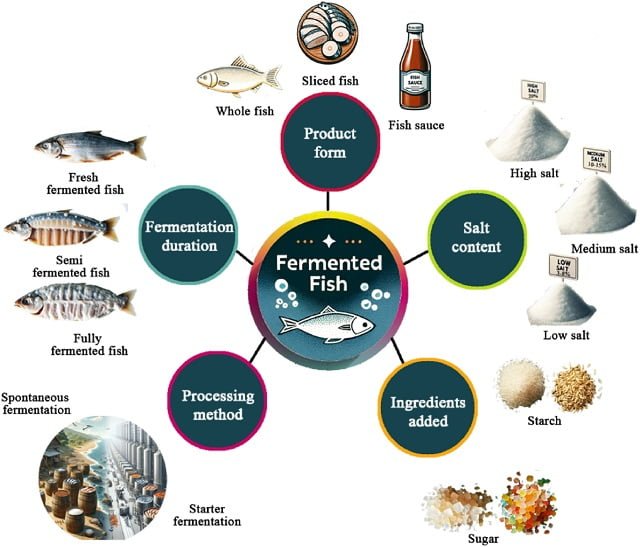
Among freshwater fish, rainbow trout (Oncorhynchus mykiss) and brook trout (Salvelinus fontinalis) are among the most prized for their delicate flavor and impressive nutritional profile.
However, discerning consumers crave more than sustenance. Transparency is paramount, and factors such as the origin of the fish, aquaculture practices, processing methods, and food composition influence purchasing decisions.
Traditional methods, such as fish smoking, resonate with this conscious shift. Smoking is an ancient food preservation method passed down through generations that has captivated palates for centuries.
Researchers from the University of Agricultural Sciences and Veterinary Medicine Cluj-Napoca, the National Institute for Research and Development of Optoelectronics INOE 2000, and Babes-Bolyai University published a study analyzing the physicochemical and microbiological safety of two traditionally smoked trout species: rainbow trout (Oncorhynchus mykiss) and brook trout (Salvelinus fontinalis).
The scientists meticulously examined the interaction between classical microbial analysis, physicochemical parameters, and the enigmatic presence of polycyclic aromatic hydrocarbons (PAHs).
Smoking
Smoking, an ancient culinary art form, was once employed as a preservation technique, extending the shelf life of fish. However, today it is considered a culinary preparation method that imparts a unique flavor and aroma to the fish.
Smoked fish, a highly valued tradition in Northern and Eastern Europe, has recently captivated the palates of Western Europe as well. Poland leads the continent as the primary producer, followed by the United Kingdom and Germany.
On the other hand, Protected Geographical Indications (PGIs) serve as a compass for discerning palates, safeguarding the authenticity and superior quality of traditionally smoked fish.
Stay Always Informed
Join our communities to instantly receive the most important news, reports, and analysis from the aquaculture industry.
Beyond its captivating organoleptic properties, smoked fish contains polyunsaturated fatty acids (PUFAs), essential amino acids, minerals, and vitamins. The antioxidant capacity of the smoke even protects beneficial compounds like eicosapentaenoic acid (EPA) and docosahexaenoic acid (DHA) from oxidation, preserving their potency.
Polycyclic Aromatic Hydrocarbons (PAHs)
However, this optimistic outlook is not without challenges. The idyllic smoke surrounding the fish during the smoking process may harbor a sinister secret: polycyclic aromatic hydrocarbons (PAHs). These unwanted compounds, formed during wood combustion, raise concerns.
Some PAHs, known for their toxicity, have been linked to cancer in humans. In alarming cases, levels of PAHs in smoked fish can exceed safe thresholds.
The culprit? Temperature.
PAHs thrive in hot smoking (70-80°C), while their formation decreases in cold smoking (28-32°C). Opting for the optimal point of 30-40°C further minimizes their harmful presence.
Unfortunately, traditional smoking methods, often based on hardwood, chips, and sawdust, tend to be “breeding grounds” for PAHs. Benzo[a]pyrene (BaP), a potent carcinogen and mutagen, serves as a grim example of these harmful compounds.
The European Commission, attentive to safeguarding public health, has set a maximum BaP threshold of 5 µg/kg in smoked fish.
Microbial Activity
Despite high temperatures and direct exposure to smoke inherent in traditional smoking, the study reports surprisingly low microbial activity in smoked trout. This highlights an essential aspect: the preservation technique effectively inhibits bacterial growth, contributing to a longer shelf life and greater safety for consumers.
PAHs: The Desired Guests
The study revealed a positive outcome: levels of benzo[a]pyrene and other concerning PAHs were undetectable in smoked trout samples. This finding suggests that traditional smoking methods when skillfully employed, can minimize the formation of these harmful compounds.
The researchers didn’t stop there.
They meticulously monitored total volatile basic nitrogen (TVB-N) levels, an indicator of fish freshness and quality. Throughout the 30-day experiment, TVB-N values remained well below the maximum limits set by EU legislation. This means that traditionally smoked trout not only possessed excellent initial quality but also maintained its freshness and safety for at least a month.
Practical Application in Aquaculture
This study paints a promising picture for aquaculturists producing smoked trout. It reveals that the traditional method, steeped in history and passed down through generations, can offer delicious and safe products, preserving quality for at least 30 days.
This knowledge allows us to make informed decisions, embrace the flavors of tradition, and employ smoking for trout preservation without compromising safety.
Conclusion
The researchers conclude that traditionally smoked trout has many advantages in terms of product quality and safety. Therefore, the products obtained are safe for consumption for at least 30 days after processing.
While this research provides valuable information, the quest to understand the complexities of smoked fish continues. Future studies may explore the impact of different types of wood and smoking temperatures on PAH formation, delve into the influence of packaging materials on shelf life, and investigate the potential for even more sustainable smoking practices.
Reference (open access)
Sava, Alexandru, Paul Uiuiu, Călin Lațiu, Daniel Cocan, George-Cătălin Muntean, Tudor Papuc, Andrada Ihuț, Camelia Răducu, Anca Becze, Cristina Craioveanu, and et al. 2023. “PAHs, Physicochemical and Microbiological Analyses of Trout Processed by Traditional Smoking, in Different Types of Packaging” Fishes 8, no. 8: 424. https://doi.org/10.3390/fishes8080424
Editor at the digital magazine AquaHoy. He holds a degree in Aquaculture Biology from the National University of Santa (UNS) and a Master’s degree in Science and Innovation Management from the Polytechnic University of Valencia, with postgraduate diplomas in Business Innovation and Innovation Management. He possesses extensive experience in the aquaculture and fisheries sector, having led the Fisheries Innovation Unit of the National Program for Innovation in Fisheries and Aquaculture (PNIPA). He has served as a senior consultant in technology watch, an innovation project formulator and advisor, and a lecturer at UNS. He is a member of the Peruvian College of Biologists and was recognized by the World Aquaculture Society (WAS) in 2016 for his contribution to aquaculture.




